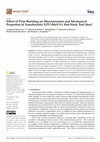Papers by Wieslaw Swiatnicki
The EBSD map is taken from a steel sample, from a region within a single bcc grain containing fcc... more The EBSD map is taken from a steel sample, from a region within a single bcc grain containing fcc precipitates after heat treatment. The sample is provided from Wiesław Świątnicki (Warsaw University of Technology).
Materials Chemistry and Physics, 2003
Transmission electron microscopy (TEM) in situ straining experiments were carried out on duplex f... more Transmission electron microscopy (TEM) in situ straining experiments were carried out on duplex ferritic-austenitic steel. Localization of strain as a common feature during slip transfer from the austenite to the ferrite has been noticed. The character of strain localization depends on the orientation relationship between the phases. A possible influence of the TEM specimen geometry on the mechanism of plastic deformation of the ferritic-austenitic steel was considered by comparing the results with those of in situ straining experiments have been performed in a 1 MV high-voltage TEM instrument.
Materials Science and Technology, 2015
The development of industry is strongly related to progress in the field of structural materials.... more The development of industry is strongly related to progress in the field of structural materials. These materials should be strong, resistant to fracture, susceptible to forming and should have beneficial service properties. Since the economic factors of materials manufacturing and exploitation are as important as the properties obtained, a high level of attention is being paid to the new generations of steels, which combine high mechanical parameters with low costs of production and processing.

Materials
The influence of prior pack boriding on the microstructure and properties of nanobainitised X37Cr... more The influence of prior pack boriding on the microstructure and properties of nanobainitised X37CrMoV5-1 hot-work tool steel was investigated in the present work. Pack boriding was conducted at 950 °C for 4 h. Nanobainitising consisted of two-step isothermal quenching at 320 °C for 1 h, followed by annealing at 260 °C for 18 h. A combination of boriding with nanobainitising constituted a new hybrid treatment. The obtained material exhibited a hard borided layer (up to 1822 ± 226 HV0.05) and a strong (rupture strength 1233 ± 41 MPa) nanobainitic core. However, the presence of a borided layer decreased mechanical properties under tensile and impact load conditions (total elongation decreased by 95% and impact toughness by 92%). Compared with borided and conventionally quenched and tempered steel, the hybrid–treated material retained higher plasticity (total elongation higher by 80%) and higher impact toughness (higher by 21%). It was found that the boriding led to the redistribution of...
Materials
The effect of a new hybrid heat treatment consisting of pack-boriding and nanobainitising on the ... more The effect of a new hybrid heat treatment consisting of pack-boriding and nanobainitising on the microstructure and properties of EN 66SiMnCrMo6-6-4 bearing steel was investigated. The hybrid treatment produces a new high-strength (ca. 1480 MPa) material with a hard boride (ca. 2000 HV0.05) surface layer and a relatively ductile nanobainitic core. The formation of the boride layer significantly improves wear resistance. The boride layer, which is hard but susceptible to cracking, reduces the mechanical properties under tensile and impact loads. However, the borided and nanobainitised steel exhibits much higher tensile strength and ductility and slightly better impact toughness than steel after post-boriding quenching and tempering.
METAL 2019 Conference Proeedings, 2019










Uploads
Papers by Wieslaw Swiatnicki